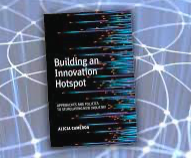
Provide the work, don’t provide the place
By Tanya Wilkins, featuring CSIRO’s Dr Alicia Cameron
It has been some 30 years since Michael Porter’s work began to filter through the minds of the world’s economics and business students. Harvard’s Porter has given the world of competitiveness his five forces: competitive rivalry, supplier power, buyer power, the threat of substitution, and the threat of new entry.
He also popularised the concept of an industry cluster, or the ‘Porterian cluster’ as they were often referred to. He is credited with many accolades as the ‘godfather’ of clusters and the impetus for the global TCI Network.
His evidence showed that being close to one another matters for economic performance. Ketels (2011) identifies Porter’s profound impact on practitioners to be the result of the actionable ideas he presents. Despite this relatability, policymakers continue to grapple with the best use of public funds to stimulate the economy.
As anniversaries of papers published come and go, those new to innovation policy work continue to discover theorists like Porter. They get swept away with creating top-down clusters and thinking that co-location of industry by governments is going to be the easy solution. But there is nothing simple about collaboration between government-industry-research. And as former innovation policymaker herself, CSIRO’s Dr Alicia Cameron knows this all too well.
Deep into her 2015-16 Smithsonian Fellowship studying innovation hotspots at the National Museum of American History, Dr Cameron realised she wanted to write a book that listed the pros and cons of different approaches to innovation to prevent innovation policy's faddishness.
In 2022, we welcomed Building an Innovation Hotspot – Approaches and Policies to Stimulating New Industry. Thank you Dr Cameron. And as David Thodey AO, ex Chair of the board of CSIRO, CEO of Telstra wrote in the foreword of the book, it is ‘a significant contribution to robust public policy required to build a more sustainable and vibrant Australia’.
In this journey, Dr Cameron built a database of around 180 Australian science and technology parks (STPs), innovation precincts, physical start-up hubs, individual incubators, innovation networks, virtual hubs, communities of practice, guilds, and industry groups.
‘It’s very dynamic and a little bit messy, and it’s hard to see what government investments have worked and what hasn’t.’
Following her time in the US, Dr Cameron felt the single most important factor that built these technology hotspots was the provision of large government procurement contracts to early-stage companies and businesses.
‘Young industry and new businesses need work contracts to survive more than they need cheap rent – particularly in the first five years.’
By using the power of government procurement, Dr Cameron believes these contracts let companies hone their technologies, create market validation, and work between government and industry to build their brand.
‘If these contracts are collaborative then longer-term partnerships can occur.’
‘Young high-tech firms sometimes need access to particular infrastructure – hospitals, quantum equipment, particle accelerators etc … but most high-tech industries – particularly in the digital sector – can cluster anywhere. The trend seems to be that increasingly they are clusters in liveable and lifestyle areas.’
Dr Cameron highlights that some of the top-down attempts with large government investments 20-50 years ago have worked. Brisbane Technology Park at Eight-Mile Plains and Macquarie Park in Sydney are examples of industrial parks with more digital workers and high-tech industry firms than their surrounding areas today.
‘Australia has had periods of trying to create innovation places through the co-location of high-tech industry – but the types of industry clusters vary greatly – from government-only university research centres that don’t have industry start-ups around them, to allocated industrial areas that try to attract high-tech firms but have little university interaction (even if they are built beside a university).’
Just how many other attempts have failed and have been erased from history? Ones that close or shut down as soon as the government funding runs out. And for those that get past the start-up phase, when the shine is still there, but the ribbon-cutting ceremony is over? Successive Australian Governments have supported a lot of successful start-ups then they are bought out or they move overseas to the larger markets (in both customers and venture capital).
‘The organisation in Australia that holds the most IP is the CSIRO—a government institution. Until we solve the problem of anchoring, Australia may continue to be a government-supported tech/IP hatchery. Only a few tech companies have decided to stay, Atlassian and Canva, for example.’
Is this the start of a new trend? If so, we need to work on the shopping list of names given to these triple helix collaborations. Recently highlighted by FIAL’s Dr Mirjana Prica – how do we know what we are talking about when we have government-industry-research coming together? Is it an innovation hotspot or a cluster? Or a precinct? Or an innovation district? Dr Cameron agrees that definitions in this field are definitely its greatest weakness.
Weakness or not, Australia is not averse to the odd challenge here or there, and Dr Cameron sees many opportunities to come together for innovation in the green energy transition, health and biomedical science, and synthetic biology.
‘We have opportunities in specialist AI development, quantum technologies, and space technologies are really starting to take off (excuse the pun).’
‘Collaboration between the government, industry, and research sectors will be essential in developing these industries and keeping them here.’
And a final word from Dr Cameron for policymakers wanting to help?
‘Provide collaborative contracts for young deep tech companies and let the industry organically cluster. The provision of infrastructure, regional branding and export assistance can then accelerate a cluster’s growth.’


